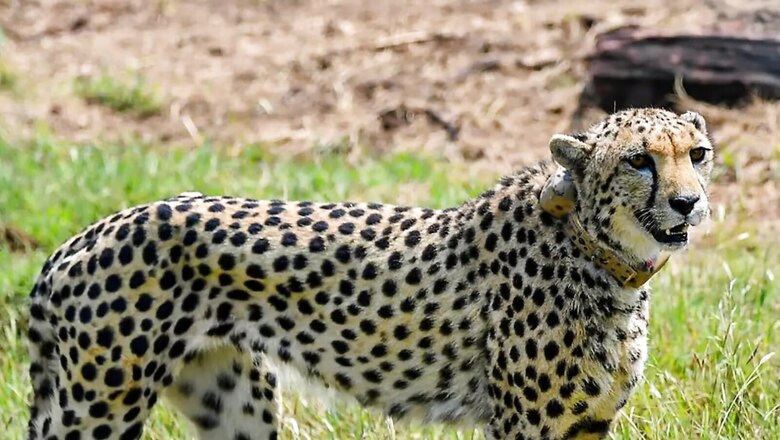
views
Seventy years after Cheetahs went extinct in India, the government began efforts to introduce the feline back into the country. Prime Minister Narendra Modi on Saturday released eight cheetahs flown in from Namibia into special enclosures in Kuno National Park in Madhya Pradesh.
But why did Cheetahs go extinct in India in the first place? There are a myriad reasons. News18 explains:
Climate Change, Low Reproductive Rate, Hunting
According to a report by National Geographic, Cheetahs are facing extinction around the world as a result of climate change, human hunting, and habitat destruction, all of which are reducing the size of their populations.
The report further explains that Cheetahs’ own genes also endanger their survival. Cheetahs have a low reproductive success rate, which means they do not always reproduce as a species. The population cannot grow or adapt to environmental changes if there are fewer offspring.
A researcher from the Indian delegation stated at the Conference of Parties to the United Nations Convention to Combat Desertification (UNCCD COP 14) that desertification was the primary cause of the extinction of the cheetah.
Too Tame, Used & Captured for Sport
But there were other causes behind the felines’ extinction in India. A report in the Hindu states that the animal’s unique characteristics contributed to its demise. One of these was that it was very easy to tame: it was frequently trained to race down and hunt animals, almost like a hound — a ‘sport’ known as coursing — and was thus captured in large numbers for use in such hunts.
An IFS officer’s illuminating thread on how the cheetahs went extinct also shares a picture from 1878 where cheetahs are shown chained like domestic dogs.
A painting from 1878 from Marriane North’s book. See how cheetah and lynxes are chained like domestic dogs. Scene is from Alwar or Rajasthan. pic.twitter.com/2131db3wCx— Parveen Kaswan, IFS (@ParveenKaswan) September 17, 2022
According to the Hindu report, the animal’s inherent docility also worked against it. The big cat was so gentle that it was compared to a dog. It never frightened people the way tigers, lions, and leopards did, the report said.
It quoted English naturalist W.T. Blanford as saying, “The hunting leopard is easily tamed, about six months being required to reduce him to a complete state of obedience and to complete his training. Many of these animals, when tamed, are as gentle and docile as a dog, delighting in being petted, and quite good-tempered even with strangers, purring and rubbing themselves against their friends, as cats do. They are usually kept, when tame, on a charpai or native bedstead, attached by a chain to the wall, and are not shut up in a cage.”
Hunted Towards Death
A report by Indian Express describes hunting as a favourite pastime of Indian royalty which carried on for centuries. The cheetah, which was easier to tame and less dangerous than tigers, was frequently used for sport hunting by Indian nobility. The earliest record of cheetahs being used for hunting in India is found in the 12th century Sanskrit text Manasollasa, written by the Kalyani Chalukya ruler, Someshvara III (reigned from 1127-1138 CE), the report says.
Wildlife expert Divyabhanusinh was quoted as saying in the report that cheetah coursing, or the use of trained cheetahs for hunting, had become a highly specialised activity in the mediaeval period and was carried out on a large scale during the Mughal empire. Emperor Akbar, who reigned from 1556 to 1605, was especially fond of the activity and is said to have collected 9,000 cheetahs in his lifetime.
Under British Rule
The IE report explains that Cheetahs underwent near extinction under the Britishers, who were uninterested in chasing cheetahs. ‘They preferred to hunt big game like tigers, bison, and elephants. Forests were extensively cleared during the British Raj in order to develop settlements and establish indigo, tea, and coffee plantations. This resulted in a loss of habitat for big cats, which contributed to their decline,’ the report says.
While tigers were the preferred prey of British shikar hunters, Indian and British “sport” hunters also pursued cheetahs. There is evidence that British officials considered the animal to be “vermin” and offered monetary rewards for killing cheetahs beginning in 1871. In Sindh, the reward for killing a cheetah cub was Rs 6, and the reward for killing an adult was Rs 12. According to environmental historian Mahesh Rangarajan, the British Raj’s administrative policy played a “major role in its (cheetah) extinction in India,” the report added.
The thread shared by the IFS officer Parveen Kaswan further shed light on how hunting affected the Cheetah’s population:
When #Cheetah are coming back to #India. A look at how the last of the lots were hunted, maimed and domesticated for hunting parties. Video made in 1939. 1/n pic.twitter.com/obUbuZoNv5— Parveen Kaswan, IFS (@ParveenKaswan) September 16, 2022
Harmful Mutations and Inbreeding a Threat
The report by National Geographic explains how Cheetahs are on the verge of extinction, despite the fact that they have previously faced and overcome the threat of extinction.
According to genetic analysis of wild cheetahs, they may have survived two historical bottlenecks, which are events that drastically reduce the size of a population.
“When this happens, the few survivors end up inbreeding or mating with relatives. Inbreeding reduces the size of the gene pool, which can lead to issues such as decreased genetic variability and the persistence of potentially harmful mutations, making it more difficult for the remaining population to adapt to environmental changes. Any mutations that occur in a very small population are much more likely to be passed on to offspring and propagate through successive generations,” it says.
Read all the Latest Explainers News and Breaking News here

















Comments
0 comment